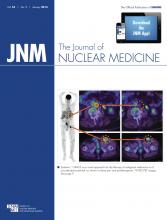The study by Hueting et al. (1) in this issue of The Journal of Nuclear Medicine reporting the biodistribution of the putative hypoxia tracer 64Cu-diacetyl-bis(N4-methylthiosemicarbazonate) (64Cu-ATSM) and that of its precursor 64Cu-acetate in mice bearing CaNT or EMT6 xenograft tumors is a timely and valuable contribution to the fields of both hypoxia imaging and metal-based radiopharmaceuticals. Although several groups have evaluated the biodistribution of 64Cu-ATSM in tumor-bearing mice, this study is apparently the first to report a detailed comparison of the biodistribution of the 2 compounds, including the effect of hypoxia on their in vivo distribution.
Hueting et al. report that 64Cu-ATSM tumor cell uptake in vitro is much higher than that of 64Cu-acetate and that 64Cu-ATSM shows hypoxia selectivity in vitro, as does 64Cu-acetate, although to a lesser degree. It is the in vivo data, however, thatSee page 128
have significant implications for 64Cu radiopharmaceuticals based on bis(thiosemicarbazone) complexes. In vivo, the 2 compounds demonstrate similar tissue distribution. Although there are differences in some tissues at 15 min after injection, the differences are minimal at 2 h after injection, and at 16 h after injection the distribution of the 2 tracers is essentially identical. Interestingly, this convergence parallels the results of the EF5 study in which the ex vivo tracer distribution of both 64Cu-ATSM and 64Cu-acetate show increasing agreement with the EF5 results over time. The converging biodistribution results are not surprising in light of the stability studies that show a 50% decrease in octanol-extractable 64Cu-ATSM after 2 h in vitro and approximately a 100% decrease by 2 h in vivo. It is also interesting to note the large discrepancy between the in vivo and in vitro protein-binding data for 64Cu-ATSM, which suggests there is some process occurring in vivo that is removing 64Cu from the 64Cu-ATSM complex that is not reflected in the in vitro protein-binding results. The striking similarity between the data for 64Cu-acetate and 64Cu-ATSM presented in this paper thus brings into question the role of ATSM in targeting the radiocopper to hypoxic cells in vivo.
There are multiple reports of the use of 64Cu-ATSM for imaging hypoxia, often including comparisons with gold standards of extreme tumor hypoxia (typically ex vivo nitroimidazole-adduct immunodetection) (2–4). However, these comparisons have often questioned the general applicability of 64Cu-ATSM as a tracer for imaging tissue hypoxia because the tumor microdistribution of 64Cu-ATSM changes over time in relation to reference hypoxia markers, the degree of agreement between the two varies significantly between tumor lines, and the extent of uptake of 64Cu-ATSM by hypoxic cells in vitro varies widely (5). In light of these studies and the current report by Hueting et al., it seems reasonable to conclude that the variation in tumor microdistribution of 64Cu-ATSM and the apparent lack of consistency of hypoxic tissue selectivity of 64Cu-ATSM may be due to differences in metabolism of radiocopper by the host organism and the tumor cells rather than by differences in tumor hypoxia.
The most obvious comparison for the current data is with that of Lewis et al. (6) who measured the biodistribution of 64Cu-ATSM and 64Cu-pyruvaldehyde-bis(N4-methylthiosemicarbazonate) (64Cu-PTSM) at early time points (up to 40 min) using a similar model system. It is notable that in this study, 64Cu-ATSM had higher uptake than 64Cu-PTSM in organs that are normally hypoxic, such as the liver, and lower uptake than 64Cu-PTSM in more oxygenated organs, such as the lung, brain, and heart. From these results and those of Hueting et al., one could infer that at early time points 64Cu-ATSM distribution is to some extent influenced by tissue hypoxia but that this may not be the primary determinant of its longer-term biodistribution. The overall pattern of distribution of 64Cu-ATSM in these 2 studies is similar (with a Pearson correlation coefficient of >0.9 in 7 common tissues), though the absolute values differ. This discrepancy is more likely due to differences in data handling between the 2 laboratories than in the models used, the only major distinction being the strains of mice used in each study.
Although it has been suggested that Cu-ATSM could be used as an agent for hypoxia detection, the greatest focus of its clinical use has been in the stratification of cancer patients for therapy with high tumor uptake of the tracer, indicating a poor prognosis (7–9). The relationship between higher uptake of a putative hypoxia tracer and prognosis appeared to be reasonable because tumors with a greater degree of tumor hypoxia tend to be more aggressive in terms of growth and metastasis (10), although the mechanism of uptake remains unknown and tumor uptake cannot now be solely ascribed to hypoxia. The results of Hueting et al. and those of similar studies with 64Cu-Cl and 64Cu-acetate suggest that it is time to reevaluate the mechanisms underlying these observations, of what we may learn from them about tumor metabolism, and of how future imaging agents can be better designed for improved tumor detection and characterization. It would also be worthwhile to evaluate the more easily prepared 64Cu-acetate as an agent for patient stratification. These results also serve to emphasize the importance of the chelator in the development of metalloradiopharmaceuticals and of using chelators that form stable complexes and verifying their stability, both in vitro and in vivo.
Whatever the findings of future studies of the mechanism of 64Cu-ATSM distribution and that of other metal-essential radiotracers, this study is an important step in the development and evolution of such imaging agents.
Footnotes
Published online Dec. 12, 2013.
- © 2014 by the Society of Nuclear Medicine and Molecular Imaging, Inc.
REFERENCES
- Received for publication October 19, 2013.
- Accepted for publication November 12, 2013.







